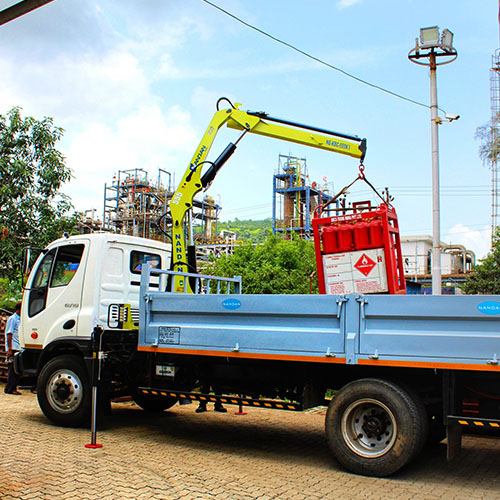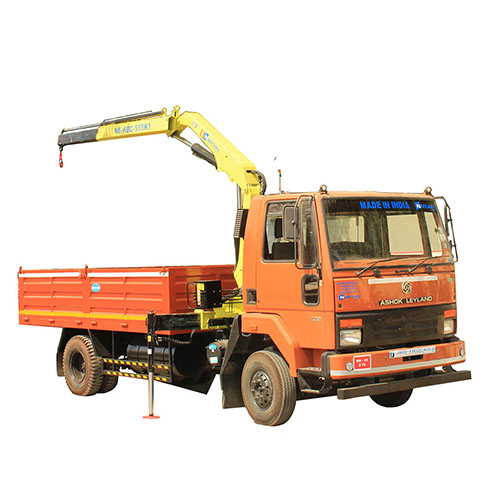Truck Cranes: Types and Uses
- Nandan GSE
- Blogs
Home » Truck Cranes: Types and Uses
Table of Contents
Looking for a detailed guide on truck cranes and their benefits? You’ve found it! This guide covers everything about truck cranes, versatile equipment used across industries like construction, logistics, forestry, and utilities. They offer various lifting capacities for different load types. With numerous options, choosing the right truck crane can be daunting. We’ll guide you through the different truck cranes—mobile, telescopic, knuckle boom—detailing their features, capabilities, and benefits. This helps you make an informed choice for your business, whether you’re expanding your fleet or need a reliable lift. Dive into this guide to understand truck cranes’ world and their significant advantages. Let’s start exploring these powerful machines.
What is a truck crane?
A truck crane is a lifting device on a standard or customized truck chassis, combining mobility with lifting capability. Designed to lift, lower, and transport materials across settings like construction sites, industrial projects, and logistics. Unlike stationary cranes, truck cranes travel on highways, moving between job sites without extra transport. This enhances utility, offering traditional crane power and truck mobility.

Benefits of Using Truck Cranes
Truck cranes offer unparalleled versatility and efficiency on the job site. One of the primary benefits is their ability to move quickly between locations, thanks to their on-road mobility. This reduces the need for additional transportation equipment and cuts down on setup time, allowing projects to progress faster. Moreover, they are designed with robust lifting capacities that can be tailored to meet the specific requirements of various tasks, from light-duty lifting to heavy-duty construction work.
Their adaptability extends to working in tight spaces where traditional cranes might not fit, providing a solution for urban construction sites and projects with limited access. Additionally, the safety features integrated into modern truck cranes, such as load moment indicators and anti-two block systems, ensure operations are conducted with the highest safety standards. The combination of mobility, lifting capacity, versatility, and safety makes them an indispensable asset for a wide range of industries.
Types of Truck Cranes
These cranes come in several types, each designed to offer specific advantages depending on the project requirements. Knuckle boom truck cranes are known for their power and reliability, utilizing hydraulic systems to lift heavy loads with precision. Lattice boom truck cranes, on the other hand, feature a lightweight boom structure that can reach higher heights, making them ideal for jobs requiring vertical reach. Telescopic truck cranes boast an extendable boom that can adjust its length, offering a blend of height and flexibility suited for various lifting tasks.
Each type has its unique set of features, from the robust lifting capabilities of hydraulic models to the high-reaching and compact designs of lattice boom and telescopic cranes. Understanding the differences between these types can help you choose the right crane for your project, ensuring efficiency, safety, and the best possible outcome.
Knuckle Boom Truck Cranes - Features and Advantages
Knuckle boom truck cranes have an articulated “knuckle” arm, mixing a truck’s compactness with a crane’s lifting precision. They fold into a small space when not used, perfect for space-limited projects. The crane’s boom moves like a finger, giving excellent control and flexibility for loading and unloading.
Their precision and versatility are key advantages. The arm maneuvers into tight spots, allowing load placement where straight boom cranes can’t. This is crucial for urban and industrial sites with space limits.

Lattice Boom Truck Cranes - Features and Advantages
Lattice boom truck cranes stand out for their lightweight design and ability to reach high elevations. Their lattice booms extend higher than other cranes, perfect for tasks needing vertical lift over long distances. These cranes are also easy to transport and assemble, thanks to their modular lattice sections. Their adaptability suits diverse sites, even those with restricted access or rough terrain. Their efficiency and flexibility make them ideal for bridge construction, tower assembly, and similar height-critical projects.

Telescopic Truck Cranes - Features and Advantages
Telescopic truck cranes offer a unique combination of compactness and extendable reach, making them highly versatile for a variety of lifting tasks. These cranes feature a boom that can extend and retract, allowing operators to adjust the crane’s reach on the fly. This adaptability makes telescopic truck cranes suitable for both short-range lifting in confined spaces and longer-range tasks where reach is paramount. Additionally, the quick setup and breakdown time of telescopic cranes enhance their efficiency, enabling faster project completion. With their ability to navigate tight spaces and adjust to diverse lifting needs, telescopic truck cranes are invaluable for construction, utility, and maintenance projects.
Factors to Consider When Choosing a Truck Crane
Selecting the right truck crane involves considering several critical factors to ensure it meets your project’s needs. Lifting capacity is paramount, as the crane must be capable of handling the weight of your specific loads. Reach is another crucial aspect, including both the height and radius the crane can cover, to ensure it can perform the required tasks. Mobility is also key, especially for projects that require the crane to move between multiple locations or operate in areas with restricted access. Evaluating these factors in conjunction with your project’s specific requirements will guide you in choosing the most suitable truck crane, ensuring efficiency, safety, and the successful completion of your tasks.
Safety Considerations
Safety is of utmost importance when operating these equipment, as the lifting and moving of heavy loads involve significant risks. Adhering to established safety protocols, such as conducting regular inspections and maintenance checks, is critical to prevent accidents. Operators must be properly trained and certified, understanding how to safely maneuver the crane and handle loads. Additionally, it’s essential to be aware of the crane’s limitations, including its maximum lifting capacity and operational boundaries, to avoid overloading or misusing the equipment. Implementing safety measures, such as using spotters and ensuring clear communication among the crew, further enhances the safe operation of truck cranes on the job site.
Maintenance and Care
Regular maintenance and proper care are essential to keep truck cranes operating safely and efficiently. This includes routine inspections to identify and address potential issues before they lead to equipment failure. Keeping hydraulic systems clean and well-lubricated ensures smooth operation, while checking structural components for wear and tear prevents accidents. Adhering to the manufacturer’s guidelines for maintenance and promptly repairing any damage extends the lifespan of the crane and maintains its reliability. Investing in the ongoing care of your truck crane not only safeguards your equipment but also protects your crew and project site.
Conclusion
Understanding the various types of truck cranes and their specific advantages is crucial for selecting the right equipment for your projects. From hydraulic to lattice boom, telescopic, and knuckle boom cranes, each type offers unique features that can enhance efficiency, safety, and flexibility on the job site. By considering factors such as lifting capacity, reach, and mobility, and implementing essential safety and maintenance practices, you can ensure the optimal use of truck cranes for your specific needs.
Contact Us
Please fill up the below details our executive will call you shortly.
